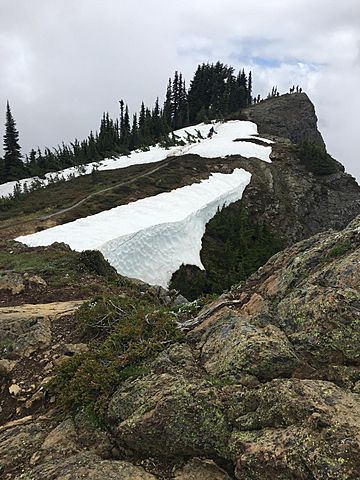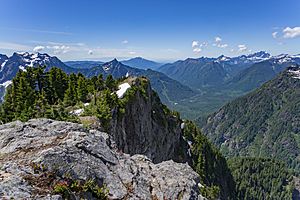Mount Dickerman facts for kids
Quick facts for kids Mount Dickerman |
|
|---|---|

View of Mount Dickerman Summit on a cloudy day.
|
|
| Highest point | |
| Elevation | 5,728 ft (1,746 m) |
| Prominence | 803 ft (245 m) |
| Geography | |
| Parent range | Cascade Range |
| Topo map | USGS Bedal |
| Climbing | |
| Easiest route | Hiking trail |
Mount Dickerman, also known as Dickerman Mountain, is a cool mountain located in the Mount Baker-Snoqualmie National Forest in Washington state. It's found northwest of Barlow Pass, right along the scenic Mountain Loop Highway. If you're up for an adventure, a challenging four-mile trail leads from the highway all the way to the top. From the summit, you can enjoy amazing views of other famous peaks like Glacier Peak, Monte Cristo Peak, and Sloan Peak.
Contents
Exploring Mount Dickerman
Mount Dickerman is a popular spot for hikers. The trail to the summit is about four miles long and can be quite a workout, but the views from the top are totally worth it! You'll see beautiful forests and, on a clear day, distant mountain ranges.
Hiking the Trail
The trail starts near the Mountain Loop Highway. It climbs steadily through thick forests. As you get higher, the trees might thin out, giving you glimpses of the surrounding area. The path is well-maintained, but it's important to wear good hiking shoes.
Summit Views
Once you reach the summit of Mount Dickerman, you'll be treated to incredible panoramic views. You can see many other peaks of the Cascade Range. It's a great place to take photos and enjoy the fresh mountain air.
Climate and Weather
Mount Dickerman is located in a special climate zone called the marine west coast climate. This means it gets a lot of influence from the Pacific Ocean.
How Weather Forms
Most weather systems start over the Pacific Ocean. They travel northeast towards the Cascade Mountains. When these weather systems hit the tall peaks of the Cascades, they are forced to rise. This process is called Orographic lift. As the air rises, it cools down and drops its moisture. This moisture falls as rain or snowfall onto the mountains.
Seasonal Conditions
Because of this, the western side of the North Cascades gets a lot of precipitation. This is especially true during the winter months, when there's a lot of snowfall. Even though it gets a lot of snow, the temperatures rarely get super cold (below 0°F or -18°C) or super hot (above 80°F or 27°C). This is because the ocean helps keep the temperatures mild.
During winter, it's often cloudy. But in summer, high-pressure systems over the Pacific Ocean usually bring clear skies. The snow here tends to be wet and heavy due to the ocean's influence. This can sometimes lead to a higher risk of avalanches, so it's important to be careful in winter.



